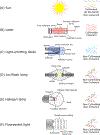Visible light. Part I: Properties and cutaneous effects of visible light
- PMID: 33640508
- PMCID: PMC8887026
- DOI: 10.1016/j.jaad.2021.02.048
Visible light. Part I: Properties and cutaneous effects of visible light
Abstract
Approximately 50% of the sunlight reaching the Earth's surface is visible light (400-700 nm). Other sources of visible light include lasers, light-emitting diodes, and flash lamps. Photons from visible light are absorbed by photoreceptive chromophores (e.g., melanin, heme, and opsins), altering skin function by activating and imparting energy to chromophores. Additionally, visible light can penetrate the full thickness of the skin and induce pigmentation and erythema. Clinically, lasers and light devices are used to treat skin conditions by utilizing specific wavelengths and treatment parameters. Red and blue light from light-emitting diodes and intense pulsed light have been studied as antimicrobial and anti-inflammatory treatments for acne. Pulsed dye lasers are used to treat vascular lesions in adults and infants. Further research is necessary to determine the functional significance of visible light on skin health without confounding the influence of ultraviolet and infrared wavelengths.
Keywords: chromophores; lasers; optical radiation; photobiomodulation; photodermatitis; phototherapy; porphyria; visible light.
Copyright © 2021. Published by Elsevier Inc.
Conflict of interest statement
Conflicts of interest Dr Lim is an investigator for Incyte, L'Oreal, Pfizer, and PCORI, has served as a consultant for Pierre Fabre, ISDIN, Ferndale, Beiersdorf, and La Roche-Posay, and has participated as a speaker in general educational session for La Roche-Posay, and Cantabria labs. Dr Kohli is an investigator (grant funding received by the institution) for Ferndale, Estee Lauder, L'Oreal, Unigen, Johnson and Johnson, Allergan, and Bayer and is a consultant (fee and equipment received by the institution) for Pfizer, Johnson and Johnson, and Bayer. Dr Jagdeo is a member of the GlobalMed Scientific advisory board and a consultant for UV Biotek. Hamzavi is an investigator for Estee Lauder, Ferndale Laboratories, Galderma, Bayer, Loreal, Lenicura, and Unigen. Geisler, Austin, and Nguyen have no conflicts of interest to declare.
Figures


References
-
- Narla S, Kohli I, Hamzavi IH, Lim HW. Visible light in photodermatology. Photochemical & photobiological sciences : Official journal of the European Photochemistry Association and the European Society for Photobiology. 2020;19(1):99–104. - PubMed
-
- Yang MF, Tuchin VV, Yaroslavsky AN. Principles of light-skin interactions. In: Light-Based Therapies for Skin of Color. Springer; 2009:1–44.
-
- Matsumura Y, Ananthaswamy HN. Toxic effects of ultraviolet radiation on the skin. Toxicol Appl Pharmacol. 2004;195(3):298–308. - PubMed
-
- Alhasaniah A, Sherratt MJ, O’Neill CA. The Impact of Ultraviolet Radiation on Barrier Function in Human Skin: Molecular Mechanisms and Topical Therapeutics. Current medicinal chemistry. 2018;25(40):5503–5511. - PubMed
Publication types
MeSH terms
Grants and funding
LinkOut - more resources
Full Text Sources
Other Literature Sources
Medical

